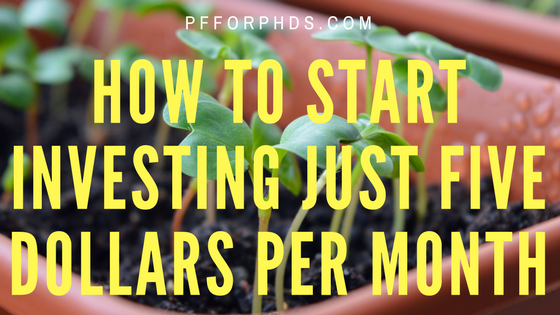In the last several years, we’ve seen an explosion of “fintech,” aka financial technology. One of those new areas is “microinvesting;” there’s never been a better time to be a beginning investor with only a small amount of cash flow available to invest. No longer must you have thousands of dollars to open an investment account or millions of dollars to receive professional investment advice. While of course it is preferable to invest a large amount of money each month for your retirement or other investing goals, sometimes that’s simply not possible. Often it’s not possible for graduate students and postdocs, yet these groups are just as intensely interested in investing as anyone else – more so, I’d wager. This post details how to start investing with just five dollars per month (or whatever amount of money you can spare right now).
Free Email Course: Investing for Early-Career PhDs
Sign up for the mailing list to receive the free 10,000-word email course designed for graduate students, postdocs, and PhDs in their first Real Jobs.
Why It’s Beneficial to Invest Just Five Dollars per Month
Thanks to the power of compound interest, a small amount of money given a long amount of time can turn into a large amount of money. That means that any amount of money you can put away when you are younger is going to make a significant difference to your wealth in retirement. It’s much, much, much better to invest $5/month than $0/month when you have decades to let it grow.
Now, you’re not going to fund your entire retirement with just a few dollars per month. But starting small is perfectly acceptable when your income is suppressed during your PhD training or you are otherwise in a financially challenging circumstance. Get started now with whatever amount you can, and increase your savings rate when your income increases and/or expenses decrease.
For example, if you contributed $5/month to an investment account over 5 years and received an 8% average annual rate of return, you’d end that time period with $367. Leave that $367 invested with an 8% rate of return for 50 years, and your ending balance is just shy of $20,000. I won’t sugar-coat it: That amount of money isn’t going to get you too far in your old age. But it is $20k better than taking no action.
Further reading:
- Why You Should Invest During Graduate School
- Whether You Save during Grad School Can Have a $1,000,000 Effect on Your Retirement
- Compound Interest
In addition to the money itself, I see two compelling reasons to start investing even with only five dollars per month:
1) Committing to an investment plan creates a habit and changes your self-identity. If you invest five dollars per month, you become an “investor.” It’s part of who you are. The positive financial habit of committing to a monthly savings rate is a very powerful one to cultivate early on in life.
2) Once you get started, it’s easy to increase. The biggest hurdle is going from investing $0/month to $5/month, not from $5/month to $100/month. If you self-identify as an investor, you are naturally going to look for ways to increase your rate of investment. When you complete your training and move into a better-paid position, you will be ready and raring to save more each month, and you’ll already have the infrastructure in place. You’ll only be a few clicks away from investing serious money each month instead of having to wrestle with all the decisions and setting everything up at the same time that you’re dealing with a job transition.
Why It’s Challenging to Invest Just Five Dollars per Month
Until a few years ago, the only way to invest a small amount of money each month and be well-diversified was to use a mutual fund. Unfortunately, to open a brokerage account in which you could buy mutual funds usually took at least $1,000 if not several thousand dollars. Even the brokerage firms that waived their minimum balances usually required an ongoing investment commitment on the order of $50 or $100/month. That barrier can seem prohibitively high to some people; instead of saving up cash for months or years to meet the minimum balance, I imagine many people gave up on the idea of investing.
Further reading: Brokerage and IRA Account Minimums
Now, however, several investing platforms use fractional ETF shares to solve this issue. The platform buys whole shares of ETFs but sells fractions to its users. In this way, a user can purchase one or more ETFs in whatever increments she likes, and there is often no minimum balance required to open the account.
(I have only included in my list below microinvesting platforms that use ETFs. Robinhood is another investing platform that I ran across many times while researching this article because it is a fee-free platform. However, it is designed for investing in individual stocks. You have to invest a lot of money to create a diversified stock portfolio through buying individual stocks. You can buy ETFs through Robinhood but not fractional shares, so that is not compatible with investing just $5 per month. I’ve decided to exclude Robinhood from my list below because it inherently encourages active investing. Of course, if that’s your preferred investing strategy and/or you have a larger amount of money to invest, Robinhood is well worth considering.)
Free Email Course: Investing for Early-Career PhDs
Sign up for the mailing list to receive the free 10,000-word email course designed for graduate students, postdocs, and PhDs in their first Real Jobs.
The Best Platforms For Investing Just Five Dollars per Month
I reviewed a number of fintech microinvesting platforms for this article, though I do not claim that it is comprehensive. I am not a customer/don’t have a relationship with any of these platforms, so I’ve drawn this information from the company websites and reviews rather than personal experience or communications.
Acorns
Acorns is probably the best-known microinvesting platform. Its concept is to round up each of your purchases to the next whole dollar and invest the change. You can also set up a recurring investment.
Fee structure: $1/month for under $5,000 (free for students for 4 years) + ETF expense ratios
IRA option: Coming “early 2018”
Portfolio creation: Suggests a portfolio of ETFs after receiving user input
WiseBanyan
WiseBanyan calls itself the “first free financial advisor.” (They earn money through upselling products and services to their clients.) The service asks you a few questions and uses Modern Portfolio Theory to construct a passive portfolio appropriate for you.
Fee structure: Only the expense ratios of the underlying funds
IRA option: Yes
Portfolio creation: Uses low-fee index ETFs according to Modern Portfolio Theory after you input data for its investor profile
Stash
Stash allows the user to choose among low-cost ETFs to create her own portfolio. The expense ratios on the ETFs are low, and Stash can recommend certain “themed” combinations of ETFs.
Fee structure: $1/month + ETF expense ratios
IRA option: In beta ($2/mo)
Portfolio creation: The user creates his own portfolio from among 40 pre-selected ETFs
Clink
Clink bills itself as more a savings app than an investing app. There is no minimum investment, but if you want to use the scheduler the minimum is $1/day. Clink invests your money in Vanguard ETFs according to Modern Portfolio Theory (a passive strategy).
Fee structure: $1/mo when balance is under $5,000 + ETF expense ratios
IRA option: No
Portfolio creation: Combines your risk tolerance with Modern Portfolio Theory to create an asset allocation of six Vanguard ETFs
In addition to these companies that are explicitly designed for microinvesting, you could also consider other brokerage firms that have wider array of financial services that includes microinvesting. For example, Betterment is a roboadvisor and has no account size minimums. If you do have a lump sum available to invest, though only $5 per month on an ongoing basis to contribute, you could consider other traditional low-cost brokerage firms like Vanguard, Fidelity, or Charles Schwab (and look around for one that will waive its minimum).
What Are the Downsides to Using a Microinvesting Platform?
The microinvesting platforms I listed above are providing a great service to a previously underserved population, and they are to be commended for that. But in order to make it possible, they have engaged in several trade-offs that wouldn’t be necessary with larger investment balances.
1) The Investment Choices Are Severely Limited
The platforms diversify your money into ETFs, but they offer only a small number of ETFs, and I suspect only a few ultimate combinations of those ETFs depending on the user’s input. This is not necessarily a bad thing. If you simply want a generally appropriate asset allocation and are not too concerned with the exact underlying funds used or the exact percentages, having those limited choices might even be advantageous. But if you want to design your own asset allocation or choose among the other thousands of funds possible, you probably won’t be too happy with these platforms.
2) The Fees Are Sky-High
There are two types of fees typically associated with owning investments. The first is due to the cost owning and transacting the investments themselves. When we are talking about an ETF, this fee is called the expense ratio and is expressed as a percentage of your investment balance. Each of the four platforms above have this fee, and it is typically quite low, approximately 0.1%. If you ever see an expense ratio that is around 1%, this is considered high and a red flag that the fund is actively managed.
The second type of fee is for administering the plan or platform itself. For reference, a full-service fee-only human financial advisor charges approximately 1%.
Three of the microinvesting platforms in my list above charge at least a $1 per month fee of the second kind. That doesn’t sound like a lot of money in absolute terms, but the whole reason we’re talking about microinvesting is because small amounts of money are worth paying attention to. If you are investing just five dollars per month, a one dollar per month fee is a staggering 20% of your savings rate. This kind of fee absolutely cripples your investing efforts. I would not be at all surprised if you lost money overall almost every year if you were investing just five dollars per month because the long-term average annual return of the stock market is approximately 10%.
Of course, you can mitigate this problem by using WiseBanyan or another platform that doesn’t charge a fee (e.g., if you are a student and can have the fee waived) or by investing more money each month.
3) They May Not Offer an IRA
Only one of the above platforms currently offers an IRA investing option to all its users. While it is great to invest outside of an IRA, if you are saving for retirement using an IRA is optimal. Plus, your IRA contribution room disappears every year. If you use a microinvesting platform for a few years as a means to save enough to open an IRA with a larger lump sum, keep in mind that your contribution room disappears with each year. It would be better to contribute to an IRA all along instead of doing it in one lump sum at the end because it would use up so much of your contribution room in the last year.
Further reading:
- Everything You Need to Know about Roth IRAs in Graduate School
- Why the Roth IRA is the Ideal Long-Term Savings Vehicle for a Grad Student
- Fellowship Recipients Can Save for Retirement Outside an IRA
- Roth vs. Traditional
4) You May Develop a Sense of Complacency
I’m trying to thread a needle here: I want to encourage you to invest any small amount of money you can right now while emphasizing that to reach financial independence or retire someday $5 per month is not nearly a high enough investing rate long-term.
If investing just five dollars per month is truly all you can do right now, go for it. But do not allow yourself to think you can keep your savings rate that low when your financial circumstances change. I want you to jump that rate up by about two orders of magnitude as soon as you are able!
Doing something is better than doing nothing, but over time you must move from doing something to doing the best thing or the sufficient thing.
Further listening: Ask Dave: Micro-Investing Apps?
How to Invest When You Have More Money
As of now, I do not think that microinvesting platforms are on par with other brokerage firms and investing platforms that require lump sums to open accounts or higher ongoing investment rates. It’s fine to start out investing with a microinvesting platform, depending on your goals, but as soon as you are able, I think you should switch to a brokerage firm that offers a wider array of investments, lower fees, and IRAs. All of the advantages of the microinvesting platforms (aside from the zero minimums) – low-cost ETF investing, asset allocation recommendations – can be found at a brokerage like Vanguard, Fidelity, or Charles Schwab. Plus, start-ups like these fin tech platforms often change their business models or fold, so even if you like your solution right now it might not be around forever.
When you do make that switch, be sure to choose a diversified, passive, low-cost strategy appropriate to your goals. And increase your savings rate!
If I were in a position to invest only five dollars per month, among the microinvesting platforms I looked at I would sign up for WiseBanyan. Because it doesn’t charge a platform fee on top of the ETF expense ratings and it offers IRAs, I think it gives you the best chance at actually readying you to invest for the long-term. But you also have to consider that it uses a freemium model, which has not yet been proven sustainable in the financial sector.







